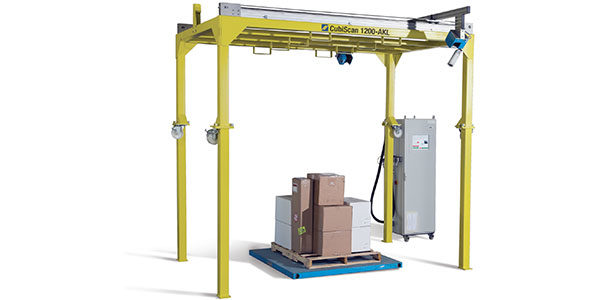A measurable difference

Anything a supply chain service provider can do to cut costs and increase capacity can help it stay competitive. Instituting a good dimensioning program is one of those things, and for many companies, the data collected represents a gold mine of information.
Panalpina is one of the world's largest supply chain solutions companies. Its 16,000 employees operate from some 500 offices in 70 countries, providing air- and ocean-freight forwarding, value-added logistics services, and other supply chain services. To better understand its loads, Panalpina relies heavily on cubing and weighing systems to gather accurate dimensional and weight data—information that can help it to better handle products and cut costs.
Panalpina measures almost all of the cartons and pallets that enter its facilities, recording their dimensions and weights. For weighing items, the company uses scales supplied by First Weight, NCI, Mettler Toledo, and others, depending on geography.
For the cubing process, the company relies on automated CubiScan systems from Quantronix at selected hub locations. These systems provide exact measurements and do so with greater precision and speed than humans can. "We want to eliminate the human element," says Tim Hotze, corporate head of the logistics competence center North America and vice president of logistics for Panalpina. "These systems are much more accurate than you or I are."
The CubiScan systems deployed at Panalpina include units that provide case-level measurements as well as models that perform dimensioning on pallet loads. For the company's transportation locations, the dimensioning information is imported into its Transit warehouse management system to facilitate dimensioning as well as transactions such as load planning and weight validations.
Similar dimensional information is gathered on cartons and load units arriving at most of the 280 warehouses that Panalpina operates worldwide. Many of these facilities also perform value-added services for clients, such as light assembly, kitting, and ticketing.
The dimensional data can also be integrated with management and slotting software to determine optimal placement of items in storage and picking areas. Panalpina deploys additional state-of-the-art warehouse design and optimization tools that allow it to create 3D models of facilities and plan slotting routines for various scenarios prior to physically changing warehouse layouts.
The company also collects the information for security reasons. Weight is recorded on inbound items and compared with the numbers recorded on the same item when weighed previously at a transit facility. If any differences exist, it may be an indication of theft or tampering during transit and can trigger additional control processes.
SPOT ON
A good example of how the CubiScan dimensioning systems function at Panalpina can be found at the company's facility in Miami. The site began using cubing systems in the late 1990s and has regularly updated its systems with the latest technology ever since.
One of the major customers serviced here is an aerospace company, for which Panalpina processes and ships parts. To help assure quality and accuracy, Panalpina automatically measures and weighs every item upon receipt at the facility. Receiving is configured with a U-shaped conveyor for handling arriving cases. In-line within the conveyor are two CubiScan 150 dimensioning units augmented with digital cameras that take pictures as each item is dimensioned and weighed. The customer can view the images and other shipment details at any time via Panalpina's track-and-trace application.
"Our warehouse agents just have to push a button," says Hotze. "That is much better than them taking a tape measure, measuring three dimensions, and inputting it into the computer. Per receipt, that time saved really adds up and drives productivity improvements. Also, the upload of the digital pictures is fully automated and allows us to offer a full audit trail to our customer."
Since many of the receipts will ship as air cargo, potentially on passenger planes, the conveyors also feed the inbound cases through a Rapiscan X-ray machine. The X-ray detection is performed as part of the Certified Cargo Screening Program and done on the inbound side so that outbound freight can be processed faster and cut-off times can be extended.
Full pallets, crated loads, and heavier freight that cannot ride on the conveyors are processed using a floor-mounted CubiScan 1200 AKL system. Weight is also captured, with the load placed on a floor scale stationed below the dimensioning system. "It's a one-step process as we take the weight, images, and dimensions at the same time on receipt," says Hotze.
The dimensional information also helps with the outbound load planning process. For instance, customer service agents can use the data to determine which cartons and freight are to be loaded into what outbound container.
Hotze says the cost of dimensioning systems has come down since Panalpina first began using them, which means the company realizes a faster return on its investment. On top of that, the machines have few moving parts, so very little maintenance is required. And he says that the integration services offered by vendors help to assure that data integrates smoothly with management software so that the information can be acted upon quickly.
Related Articles

Copyright ©2024. All Rights ReservedDesign, CMS, Hosting & Web Development :: ePublishing